Posts Tagged ‘Royal Mint’
World Coins struck by The Royal Mint
It’s common knowledge among Change Checkers that The Royal Mint strikes all the coins in the United Kingdom – and has done for centuries.
But what may come as a surprise to many collectors is The Royal Mint has historically struck coins for a variety of countries around the world!
Currently, outside of the UK, The Royal Mint provides services for over 60 different countries, including New Zealand and many Caribbean nations.
In the past, The Royal Mint has struck coins for North and South America, Africa and the Middle East!
In this blog, we take a look at our Top Five most interesting world coins struck by our very own UK Royal Mint and the stories behind them.
“From Norway to New Zealand, from Bermuda to Brunei, coins have been struck at The Royal Mint for countries all over the world.”
– The Royal Mint Museum
New Brunswick 1861 Half-Cent
Across the 18th and 19th centuries The Royal Mint, which was then based in London, minted several coins for North American states and the Caribbean.
Interestingly, in 1861 a half-cent coin, made of bronze, was minted for New Brunswick. More than 200,000 of these half-cent coins were struck, even though the denomination wasn’t actually needed.
It is said these coins were struck as a misunderstanding at The Royal Mint (that’s quite a misunderstanding!) and the majority of these were melted down. However, there has been reports that a lucky few coins have survived!

Norway 1942 25 Aurar
Many Change Checkers might be familiar with some of the coins struck by the UK Royal Mint throughout the Second World after reading our blog featuring coins struck in the UK for Iceland.
In addition to this a coinage was undertaken in the Second World War for the Norwegian government in anticipation of the country’s liberation from occupying forces.
Made out of Nickel-Brass and shipped to Norway ready for their liberation, this could have been one of the most exciting Norwegian coins in circulation.
However, the coin was never issued and the large majority of these were returned to The Royal Mint a few years later and melted down.

Nigeria 1959 Shilling
This Nigerian Shilling was made out of Cupro-Nickel, the same composition we are familiar with on modern United Kingdom 50 pence coins.
With an order of more than 1,000 million pieces for this new, distinctive Nigerian coinage, this is by far the largest international coin order The Royal Mint had ever received – quite the honour!

Hong Kong 1863 Mil
Introduced in 1863, the Hong Kong Mils were the first-ever perforated coins to be produced at The Royal Mint.
Perforated coins usually refer to coins which have a hole punched through the middle.
To date, although The Royal Mint have produced this style of coins for several other nations including East Africa, the United Kingdom has never had a perforated coin in their tender.

Australia 1951 Penny
Demand for Australian coinage in 1951 exceeded the capacity of the Brand Mints in Melbourne and Perth, and so the UK Royal Mint was approached for assistance.
Interestingly, the Australian coinage pieces struck in London are distinguishable by the addition of the tiny letters ‘PL’ which recalls a mintmark used by the UK Mint in Roman times.

So, there we have it! Our Top Five most interesting coins struck by the UK Royal Mint for countries around the world!
These coins tell quite the story of The Royal Mint’s long and important history in world coinage.
If you have any exciting coins from around the world or stories you’d like to share, let us know in the comments below!
If you’re interested in coin collecting, our Change Checker web app is completely free to use and allows users to:
– Find and identify the coins in their pocket
– Collect and track the coins they have
– Swap their spare coins with other Change Checkers
Sign up today at: www.changechecker.org/app
The coins born from war and ice…
During its lifetime, The Royal Mint has struck coins for over 100 different countries from around the globe.
But do you know the story of how they came to strike Icelandic coinage?

The ‘inauguration’ of Iceland’s coinage
The story of how The Royal Mint came to strike Iceland’s coins began in World War Two.
After a night where the windows and roofs of The Royal Mint at Tower Hill had been destroyed by enemy action, the very first British-struck Icelandic coins were born as “a glacial wind whirled round the coining presses to inaugurate this coinage of Iceland” (explained by John Craig, The Deputy Master of The Royal Mint, in his annual report).
Prior to World War II, Iceland was ruled by the Danish crown and Icelandic coins had been struck by The Copenhagen Mint.
But the fall of Denmark into enemy hands during the war meant that Iceland had to look elsewhere for its coinage requirements…
First ever British-struck Icelandic coins
It was in 1940 that The Royal Mint received its first order to strike the five Icelandic denominations from 1 Eyrir (0.01 Krόnur) to 25 Aurar (0.25 Krόnur).
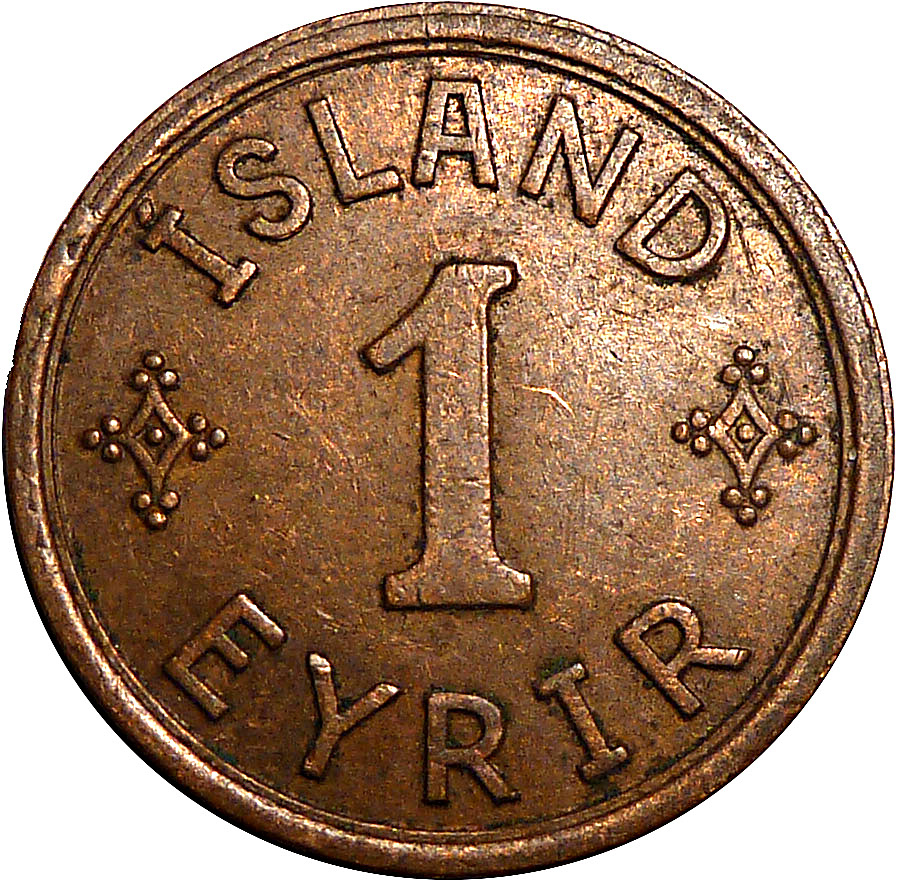
This was soon followed by additional orders for Krόnur and 2 Krόnur coins.
Not only did The Royal Mint experience damages to the building during WWII, but the price of nickel also rose substantially as the metal was in extremely high demand for munitions.
This meant it became necessary to strike the 1942 dated 10 and 25 Icelandic Aurar coins in the ‘poor metal’ of zinc rather than the now commonly used Cupro-nickel.
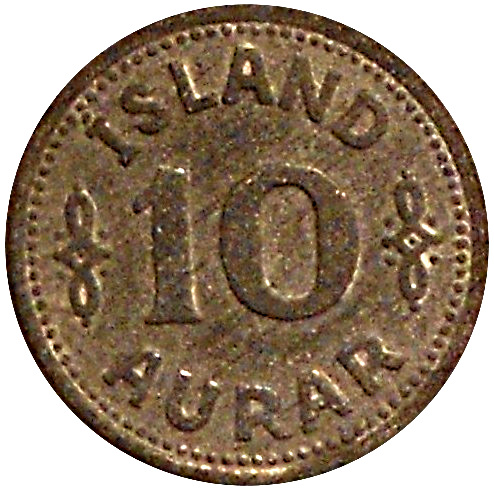
The new coins series
In June 1944 Iceland became a republic. A new series of coins were introduced in 1946, which remained in use for the next 35 years.
A full rendering of the national Coat of Arms appeared on the Krόnur and 2 Krόnur, complete with the bull, eagle, dragon and giant supporters.
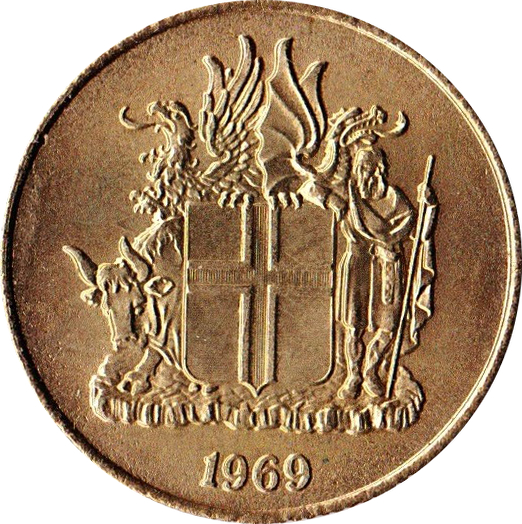
Four new denominations were added in the late 1960s, including the 50 Aurar, 5 Krόnur, 10 Krόnur and 50 Krόnur.
Iceland’s first commemorative coins
Iceland’s first commemorative coin was struck at The Royal Mint in 1961 – a gold 500 Krόnur marking the 150th anniversary of the birth of the scholar and statements, Jόn Sigurdsson.
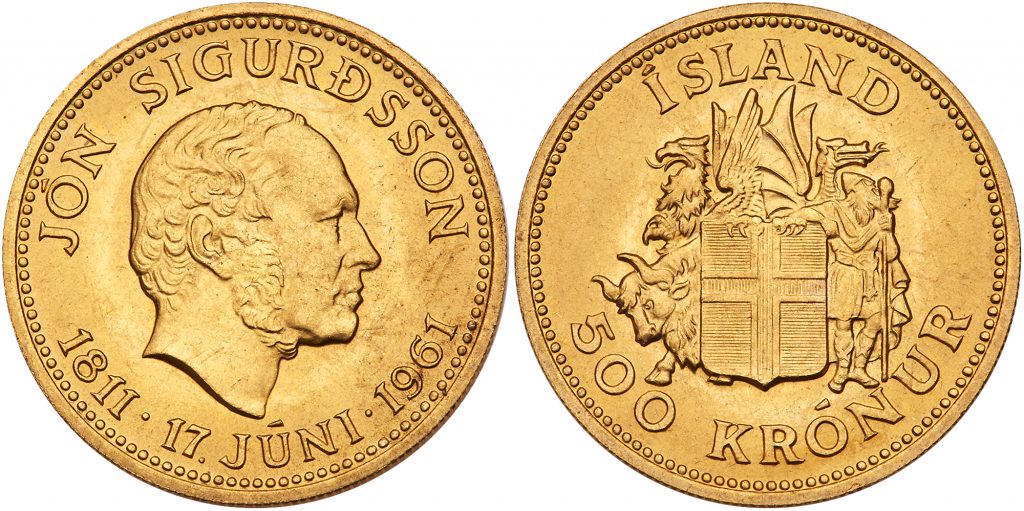
Iceland became a free and sovereign nation in 1918 when the Union Treaty with Denmark came into effect on the 1st December. To commemorate 50 years since this historic moment, a 50 Krόnur coin was issued.
In its first year of issue in 1968, the reverse design of the 50 Krόnur included a representation of the Althing (Parliament) building and carried an inscription marking the 50th anniversary of the achievement of Icelandic national sovereignty.

In 1974, The Royal Mint issued a three coin series of gold and silver coins, designed by Throstur Magnusson to commemorate the 1100th anniversary of the settlement of Iceland.
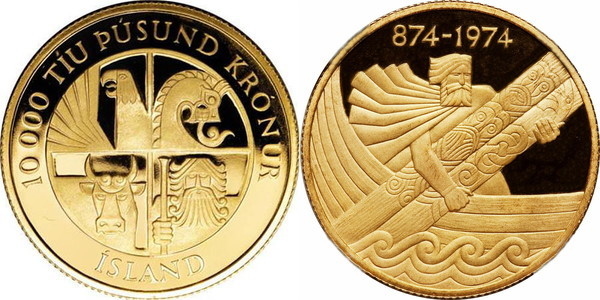
A major reform to Iceland’s coinage
The Icelandic financial market suffered hyperinflation in 1981, which was settled by a major reform of the coinage, resulting in a complete redesign and revaluation of the circulating coins.
100 old Krόnur was now worth just 1 new Krόna. As well as 1 and 5 Krόna coins, denominations of 5, 10 and 50 Aurar were also introduced.
The new obverses, in keeping with Magnusson’s designs, depicted the traditional protector spirits (“Landvættir”) of Iceland.

Each reverse portrays a variety of aquatic life, including dolphins, cod and northern shrimp.
As Iceland’s economy has been founded on fishing for so long, the pungent smell of fish smelting came to be known as “money smell”.
It’s great to discover more about different coins from around the world, and I’m sure you’ll agree that the stories behind Icelandic coinage are really fascinating.
If you’re lucky enough to have come across any Icelandic coins during your trips abroad, let us know in the comments below.
If you’re interested in coin collecting, our Change Checker web app is completely free to use and allows users to:
– Find and identify the coins in their pocket
– Collect and track the coins they have
– Swap their spare coins with other Change Checkers

Sign up today at: www.changechecker.org/app
The UK Coin Series celebrating one of Britain’s most iconic attractions…
The Tower of London has been a symbol of royal power for nearly 1,000 years.
Built during the Norman conquest in 1066, Her Majesty’s Royal Palace and fortress of the Tower of London has been used as a prison, jewel house, mint and even a menagerie!
It’s been home to kings and queens, thieves and traitors, and lions and bears.
In tribute to the Tower, The Royal Mint announced they would be issuing a four coin series throughout 2019 celebrating the history of the Tower of London, one of Britain’s most iconic attractions. The series included coins depicting the following:
- The Legend of the Ravens
- The Crown Jewels
- The Yeoman Warders
- The Ceremony of the Keys
2019 The Legend of the Ravens £5
Featuring a Raven with a bird’s-eye view of the Tower in the background, the first coin in the series captures the illustrious history of the iconic British landmark and its most famous residents.

The Tower’s ‘raven mythology’ is thought to be a Victorian flight of fantasy and has been a source of many legends, including the fate of Greenwich observatory.
It’s said that King Charles II disliked the raven’s droppings falling onto the telescope at the Tower’s observatory, and so ordered that the ravens must go. However, superstition stated that if the ravens left, the Tower would fall and Charles would lose his kingdom. Ever the pragmatist, the King decided that the observatory must go to Greenwich and the ravens must stay in the Tower.
2019 Crown Jewels £5
The second coin to be issued in The Royal Mint’s Tower of London series was the Crown Jewels £5.

Several expansions were made to the Tower throughout the reign of Kings Richard I, Henry III and Edward I in the 12th and 13th centuries, however in general the original layout remains consistent. It suffered structural damage during the Blitz, but this was repaired after the Second World War and the Tower was opened to the public, to marvel at the Tower’s most esteemed treasures – the Crown Jewels!
Not only a powerful symbol of the British Monarchy, the jewels have deep religious and cultural significance in British history and are used by HRH King Charles III for important ceremonies and royal duties.
However, the 12th century anointing spoon and three early 17th century swords are the only four original jewels left after the English Civil War in 1649, when the Crown Jewels were destroyed and the monarchy abolished. The jewels were remade for Charles II’s coronation in 1661 following Oliver Cromwell’s death.
2019 Yeoman Warders £5
The third coin in the series celebrates the Yeoman Warders, who’ve have been guarding the Tower of London for more than 1,000 years.

Nicknamed as ‘Beefeaters’, they originally formed the Yeoman of the Guard, which was the monarch’s personal team of bodyguards.
The Yeoman Warders were responsible for looking after the prisoners in the Tower and protecting the crown jewels, however nowadays they also conduct guided tours of the Tower and are an important icon for Britain, resplendent in their red uniforms and a favoured tourist attraction.
It’s no mean feat to become a Warder however, as you need to be between 40 and 55 years old on appointment and hold at least 22 years’ military service, during which time you must have reached the rank of warrant officer and to have been awarded the long service and good conduct medal.
2019 Ceremony of the Keys £5
The fourth and final coin in the Tower of London series celebrates the Ceremony of the Keys. Designed by Glyn Davies the reverse of the coin depicts the keys and lamp which take centre stage in the ceremonial unlocking of the Tower of London gates.
For over 700 years, as the clock strikes ten, the words ‘Halt! Who comes there?’ echo in the Tower of London. The ancient Ceremony of the Keys is a formal locking and unlocking of the Tower gates, which started in the mid 1300s on order of King Edward III after he entered the Tower unannounced one night and was able to walk straight in, unchallenged!
Tradition states that at exactly seven minutes to ten at night, the Chief Yeoman Warder of the Tower must leave the Byward Tower, wearing a red Watch Coat and Tudor Bonnet and carrying a lantern. He takes with him a very special set of keys – the King’s Keys.
A military escort meets him at the Bloody Tower and at 10pm he moves two paces forward, raises his Tudor bonnet and says: ‘God preserve King Charles’. This is answered by ‘Amen’ from the guards and ‘The Last Post’ played on a bugle.
The keys are then taken back to the King’s House and handed to the King’s representative at the Tower, The Resident Governor.
Did you know? When all four coins in the series are placed together, they reveal a larger image showing the Tower of London walls connecting.

Which coin in the 2019 Tower of London series is your favourite? Let us know in the comments!
The Tower of London £5 series continued in 2020 with four more coins celebrating the iconic attraction.





